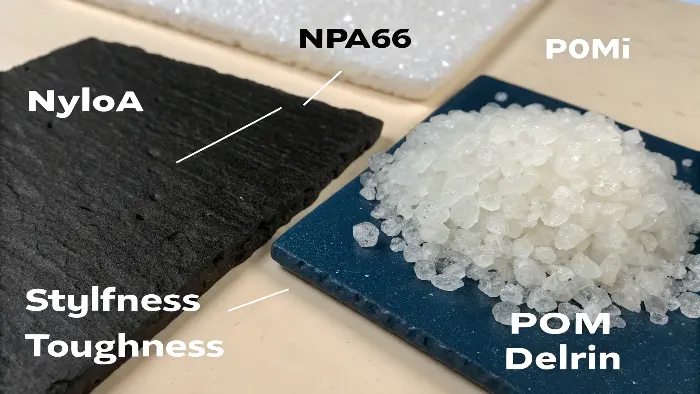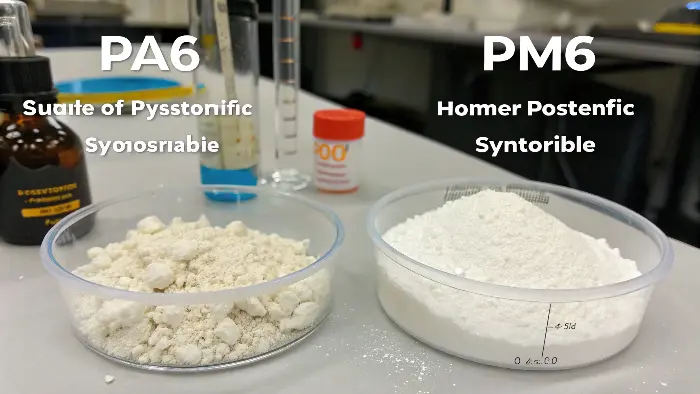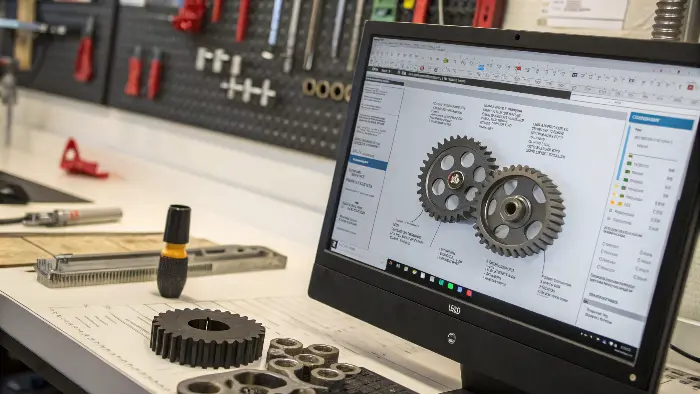Choosing the wrong engineering plastic can lead to part failure, costly redesigns, and frustrating production delays. You have two excellent options, Nylon (PA66) and POM (Delrin), but they are not interchangeable. A gear that wears out too fast or a clip that snaps under pressure can ruin a product’s reputation. Making the wrong choice here wastes valuable time and money. Understanding their key differences will help you select the perfect material for your specific needs, every single time.
The best choice depends entirely on your application’s demands. Choose POM (like Delrin) for parts that require high stiffness, exceptional dimensional stability, and low friction, such as precision gears, bushings, and bearings. On the other hand, you should opt for Nylon (PA66) when you need superior toughness, impact resistance, and flexibility. This makes it ideal for components like snap-fits, living hinges, and parts that must endure repeated stress without failing. Each material excels in very different high-performance scenarios.

I’ve seen countless designers, even experienced ones like Jacky, struggle with this choice over the years. It’s a classic engineering dilemma because both materials are fantastic performers in their own right. But their true strengths lie in completely different areas, and confusing them can be a costly mistake. To really master your material selection, we need to break down the details. Let’s dive deep into the specifics so you can make your next decision with total confidence and get your molding right from the start.
What is the Difference Between Delrin and POM Plastic?
You constantly see "POM" and "Delrin" on spec sheets and in technical discussions, but are they actually the same thing? Using the wrong term can create confusion with your suppliers and even lead to ordering an incorrect material grade. This seemingly small mistake can cause big problems in production and part performance. Let’s clear this up right now so you always know exactly what you are working with and can specify your materials with precision.
POM, which stands for Polyoxymethylene, is the chemical name for the family of engineering thermoplastics. Delrin® is simply a well-known brand name for a type of POM homopolymer manufactured by DuPont. So, while all Delrin is POM, not all POM is Delrin. Other brands exist, and there are also POM copolymers, which have slightly different properties. Think of it like "facial tissue" (the generic product, POM) versus "Kleenex®" (a specific brand, Delrin).

To really understand this, it helps to know that POM comes in two main commercial types: homopolymer (POM-H) and copolymer (POM-C). Delrin® is the most famous example of a POM-H. Both types are acetals, but they have subtle differences in their chemical structure that affect their performance. I remember a project where a client specified "POM" for a part that would be constantly exposed to hot, soapy water. We knew that a standard POM-H like Delrin could struggle with long-term exposure to hot alkaline solutions. So, we recommended a POM-C grade instead, which has superior chemical resistance in those conditions. That small detail saved the client from potential field failures down the line. It’s a perfect example of why knowing the difference matters.
Homopolymer vs. Copolymer
The choice between POM-H and POM-C often comes down to a trade-off between mechanical performance and chemical or thermal stability.
| Feature | POM Homopolymer (e.g., Delrin®) | POM Copolymer (e.g., Ticona Celcon®) |
|---|---|---|
| Stiffness & Strength | Higher tensile strength and rigidity. | Slightly lower, but still very stiff. |
| Creep Resistance | Excellent, better for long-term loads. | Very good, but slightly less than POM-H. |
| Centerline Porosity | Can be an issue in thick-walled parts. | Generally less prone to porosity. |
| Chemical Resistance | Good, but less resistant to hot water/alkalis. | Excellent, especially against hot water/alkalis. |
| Thermal Stability | Good, but lower long-term thermal stability. | Better long-term thermal stability. |
In short, if your design requires the absolute maximum stiffness and strength, and it won’t be in a chemically harsh environment, a POM-H like Delrin is a fantastic choice. If your part needs to survive exposure to hot water, steam, or certain chemicals, or if you’re molding a very thick part where porosity could be a problem, a POM-C is often the safer and more reliable option.
What is the Core Difference Between PA66 and POM Material?
You need a part that is strong and durable, but PA66 and POM offer very different kinds of strength. Choosing a material based on a simple "strong" label can lead to unexpected and catastrophic failures in the field. A part might be incredibly stiff but shatter on impact, or it might be tough but too flexible for its job. Let’s put these two materials side-by-side to compare their most important core properties and understand their unique strengths.
The most critical difference between PA66 and POM lies in how they interact with moisture. PA66 is hygroscopic, meaning it readily absorbs water from the environment. This absorption makes it significantly tougher and more impact-resistant, but it also causes it to swell and lose dimensional stability. In contrast, POM absorbs very little water, giving it excellent dimensional stability, consistent stiffness, and predictable properties in both wet and dry conditions. This is the single most important distinction for any designer to understand.

This difference isn’t just academic; it has massive real-world consequences. I learned this the hard way early in my career. We manufactured a set of tight-tolerance gears from PA66 for a device that was going to be used in a humid, tropical climate. In our dry, air-conditioned lab, they worked perfectly. But a few weeks after the product launched, we got reports that the mechanism was jamming. We discovered the PA66 gears had absorbed moisture from the air, causing them to swell just enough to increase their diameter and ruin the precise gear mesh. We had to remake the entire batch in POM. The problem vanished instantly. It was a tough, expensive lesson on the critical importance of dimensional stability.
Material Properties at a Glance
Let’s break down the key performance metrics in a simple table. This is the kind of chart I keep handy when I’m starting a new project.
| Feature | Nylon 66 (PA66) | POM (Acetal/Delrin®) |
|---|---|---|
| Toughness & Impact | Excellent, especially when moisture-conditioned. | Good, but more rigid and can be notch-sensitive. |
| Stiffness & Hardness | Good, but lower than POM. Becomes more flexible with moisture. | Excellent. Very rigid, hard, and crystalline. |
| Friction & Wear | Good, naturally lubricious. | Excellent, one of the best plastics for low friction. |
| Moisture Absorption | High (can be 2.5% or more by weight). | Very Low (typically less than 0.25%). |
| Dimensional Stability | Poor. Dimensions change significantly with humidity. | Excellent. Very stable in most environments. |
| Operating Temp. | Higher continuous use temperature (up to 120°C). | Lower continuous use temperature (up to 90°C). |
| Chemical Resistance | Good against oils, greases, and fuels. | Excellent against solvents, fuels, and alcohols. |
The Critical Role of Moisture
For PA66, water acts as a plasticizer. When the material is bone-dry, it’s quite rigid but also more brittle. As it absorbs moisture, the polymer chains can move more freely, which dramatically increases its toughness and impact strength. This is why PA66 is often "conditioned" with moisture after molding to achieve its optimal properties. However, this same process causes the material to swell and lose some of its stiffness and tensile strength. For a designer like Jacky, this means you must account for these dimensional changes in your design if the part will operate in varying humidity.
POM, on the other hand, is hydrophobic. Its properties remain remarkably consistent whether it’s in a desert or a rainforest. This predictability is its superpower. When you need a part to hold its tolerance no matter what, POM is your reliable choice.
So, Which is Better for Your Application, Nylon or Delrin?
Theory is great, but how do you apply it to the actual part on your screen? You’re looking at your CAD model, wondering if that gear needs more precision or if that clip needs more flex to survive. Making the wrong call means going back to the drawing board, wasting time and resources. Let’s move past the data sheets and look at real-world examples to make this critical choice simple and clear.
Neither material is universally "better"; the best choice is always driven by the specific application. Use Delrin (POM) for parts that demand precision, low friction, and unwavering stability, like gears, bearings, bushings, and fuel system components. Choose Nylon (PA66) for parts that need to be exceptionally tough, flexible, and able to absorb impacts, such as snap-fit connectors, living hinges, impact-absorbing housings, and high-load structural parts.

I have a simple rule of thumb that I share with all the designers I work with: "If it needs to stay put and slide smoothly, think POM. If it needs to bend and not break, think Nylon." This little mental shortcut has saved us from countless hours of debate and potential redesigns. It forces you to think about the primary function of the part. Is its job to transmit motion precisely, or is its job to hold things together and survive abuse? Answering that one question will point you to the right material 90% of the time.
When to Choose POM (Delrin®)
Think of POM as the precision machinist of the plastics world. Its strengths are ideal for parts that are part of a larger mechanical assembly.
- Precision Gears: POM’s high stiffness and incredible dimensional stability ensure that the gear tooth profile remains exact. This prevents backlash, ensures smooth power transmission, and guarantees reliability over millions of cycles.
- Bearings and Bushings: POM’s naturally low coefficient of friction and excellent wear resistance make it a perfect replacement for metal in many bearing applications. It runs quietly and often requires no external lubrication.
- Fuel System Components: In automotive applications, parts are exposed to gasoline and other solvents. POM’s excellent chemical resistance and stability in these fluids make it the go-to material for fuel pump housings, caps, and float components.
- Medical Device Components: For devices like insulin pens that must deliver a precise, repeatable dose, POM’s stability is non-negotiable. It ensures the mechanism works flawlessly every time.
When to Choose Nylon (PA66)
Think of Nylon as the tough brawler. It’s built to take a punch, bend under pressure, and keep going.
- Snap-Fit Latches and Clips: This is a classic application for Nylon. A snap-fit needs to flex significantly to engage and disengage, potentially thousands of times. PA66’s flexibility and fatigue resistance are perfect for this. A POM snap-fit would be too rigid and could easily break.
- Power Tool Housings: The housing of a drill or saw needs to protect the internal components from drops and rough handling on a job site. PA66’s superior impact strength absorbs that energy, preventing the housing from cracking or shattering.
- Wheels and Rollers: For applications like caster wheels or conveyor rollers, PA66’s toughness and load-bearing capacity are key. It can handle high loads and resist abrasion from rolling contact.
- Cable Ties and Fasteners: The flexibility and high tensile strength of PA66 make it the universal material for cable ties. It can be pulled tight without snapping and holds its grip reliably.
Conclusion
The choice between Nylon (PA66) and POM (Delrin) is not about finding a "better" material, but about selecting the "right" one for the job. POM delivers precision, stiffness, and stability for intricate mechanical parts. Nylon provides unmatched toughness, flexibility, and impact resistance for structural and dynamic components. Understanding this fundamental difference empowers you to design more robust, reliable parts and truly master your material selection process, getting your molding right every time.
